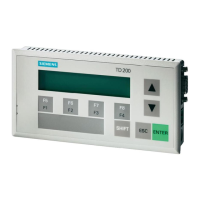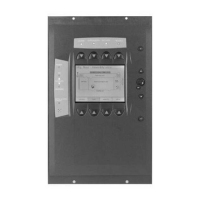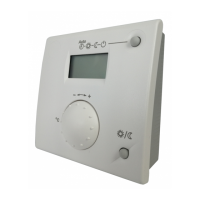D-13
SIMATIC TD 200 Operator Interface
C79000-G7076-C272-01
Defining the Data Value Format
Figure D-10 shows the bit values of Byte 0 and Byte 1 of the format word. Byte 0
uses only five bits (bits 0 through 4). Byte 1 uses only six bits (bits 0, 1, 2, and 4,
5, 6). All other bits of the byte (for both Byte 0 and Byte 1) must be set to zero.
Format Word Optional Data Value
Byte 0 Byte 1 Byte 2 Byte 3 Byte 4 Byte 5
MSB of
Format
LSB of
Format
MSB of
Data
LSB of
Data
0 0 0EPEN A
76543210
MSB LSB
AN
E - Edit Allowed
EN - Edit-Notification
A - Acknowledgement
AN - Acknowledgement-Notification
P - Password Protected
0
Format Word Optional Data Value
Byte 0 Byte 1 Byte 2 Byte 3 Byte 4 Byte 5
MSB of
Format
LSB of
Format
MSB of
Data
LSB of
Data
S SS0 D D
76543210
MSB LSB
D
D - Placement of the Decimal Point
S - Data Size/Format
Byte 0
Byte 1
Figure D-10Bit Values of the Format Word
Do not use non-printable characters in your message text: the TD 200 uses these
characters to identify the start of a format word. The non-printable characters are
ASCII codes 0 to 31 (0 to 1F hexadecimal).
Acknowledgement Bit 0
To ensure that important messages are displayed and acknowledged by an
operator, you can program a message to require acknowledgement. You do this by
setting the acknowledgement bit in the most significant byte of the format word.
Figure D-11 shows the placement of the acknowledgement bit in byte 0 of the
format word.
A - Acknowledgement
0 - No acknowledgement
1 - Acknowledgement required
Format Word Optional Data Value
Byte 0 Byte 1 Byte 2 Byte 3 Byte 4 Byte 5
MSB of
Format
LSB of
Format
MSB of
Data
LSB of
Data
0 0 0EPEN A
76543210
MSB LSB
AN
Figure D-11 Acknowledgement Bit of Byte 0 of the Format Word
TD 200 Parameters and Messa
es

